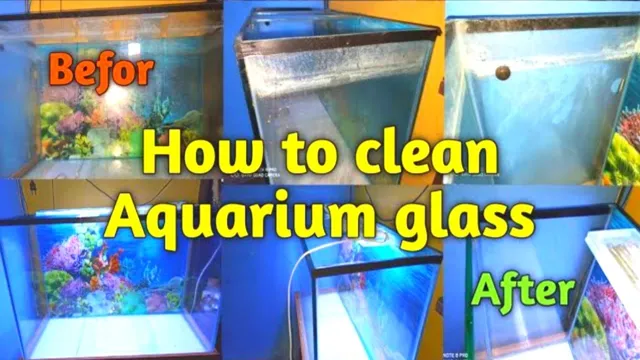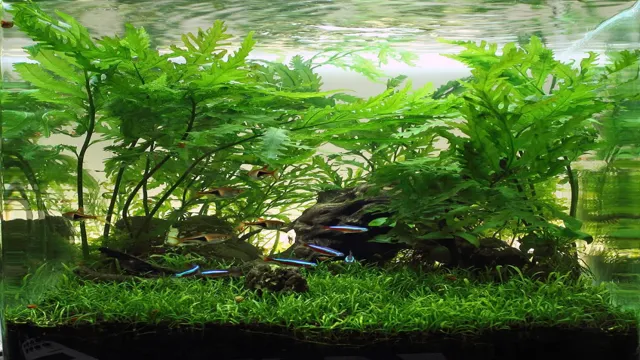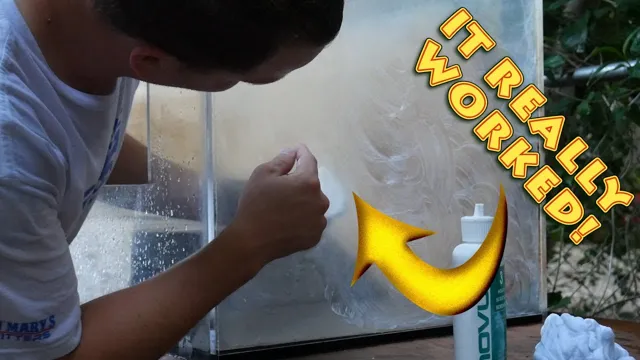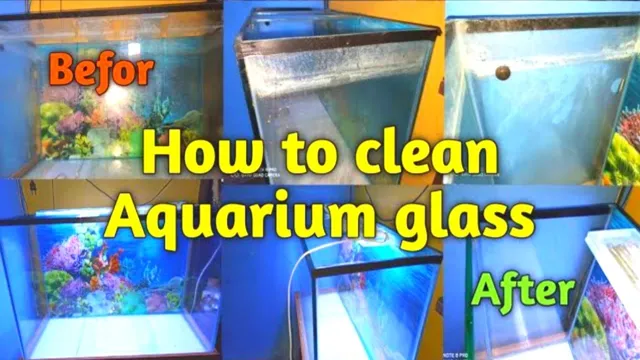How to Get Hard Water Stains off Aquarium: Tips and Tricks

When it comes to aquarium maintenance, removing hard water stains can be a real pain in the glass. Not only are these stains unsightly, but they can also be harmful to your aquatic pets if left unattended for too long. Hard water stains are caused by the buildup of minerals such as calcium, magnesium, and silica, which can accumulate on the surface of the aquarium glass over time.
Not to worry though, as there are several effective methods to get rid of those pesky stains and restore the crystal-clear clarity of your aquarium. Whether it’s using vinegar and baking soda, commercial cleaners, or even a good old-fashioned razor blade, we’ve got you covered with expert tips and tricks for removing hard water stains from aquariums. So if you’ve been struggling with cloudy, grimy glass and don’t know where to start, look no further.
In this guide, we’ll dive into the nitty-gritty of hard water stains and provide you with everything you need to know to keep your aquarium sparkling clean and your fish and plants thriving. Let’s get started!
Understanding Hard Water Stains
If you’re a proud aquarium owner, you may have noticed hard water stains appearing on the glass of your tank. These unsightly marks are caused by mineral deposits found in hard water, which can leave a residue on your aquarium over time. Removing hard water stains can be a frustrating and time-consuming process, but there are a few methods you can try to get your aquarium looking crystal clear again.
One effective way to remove hard water stains is by using a mixture of vinegar and water. Simply mix equal parts vinegar and water in a spray bottle and spritz the affected areas, then let it sit for a few minutes before wiping it off with a cloth. For tougher stains, you can try using a commercial aquarium glass cleaner or a scraper tool to gently remove the buildup.
With a little persistence and patience, you can keep your aquarium looking its best and ensure your fish have a happy, healthy environment to call home.
What are hard water stains?
Hard water stains are mineral stains caused by the buildup of calcium and magnesium on surfaces that come into contact with hard water. Hard water is water that contains high levels of these particular minerals, and over time, they can leave behind unsightly marks on your shower doors, sinks, and faucets. These stains can be challenging to remove with regular cleaning solutions, and they often require the use of special cleaning products.
Understanding the difference between hard and soft water can help you prevent the buildup of these stains, but if you find yourself dealing with them already, there are some effective ways to remove them. By using a combination of vinegar, baking soda, and elbow grease, you can effectively clean your surfaces and restore them to their original shine. Overall, hard water stains are an unpleasant side effect of having hard water, but they are not impossible to remove with the right tools and methods.

Why are they harmful to aquariums?
Aquariums, Hard Water Stains Hard water stains can be a source of frustration for any aquarium owner, but they can also be harmful to the overall health of your aquatic pets. Hard water is water that contains a high concentration of minerals, such as calcium and magnesium. When this water evaporates, it leaves behind unsightly and stubborn stains on tank walls and surfaces.
These stains can be difficult to remove and can even damage the glass or acrylic of the tank over time. But hard water stains aren’t just an eyesore – they can also negatively impact the pH balance of your aquarium’s water. As the minerals in hard water build up over time, they can alter the water’s chemical composition, making it more alkaline and less hospitable to the sensitive and delicate ecosystems that exist within the tank.
Fish, plants, and invertebrates all rely on a specific balance of minerals, nutrients, and pH levels to thrive, and hard water stains can throw this delicate balance out of whack. To keep your aquarium healthy and your water crystal clear, it’s important to regularly test your water for hard water levels and take steps to reduce mineral buildup as needed. This might involve using specialized cleaners or additives, such as vinegar or citric acid, or investing in a water softening system.
By staying on top of hard water stains and taking steps to minimize their impact, you can ensure that your aquarium remains a happy and healthy home for your aquatic pets.
Materials Needed for Cleaning
If you’re struggling with hard water stains in your aquarium, you’re not alone. These stubborn marks can make your aquarium look dirty and unappealing. But fear not, with the right materials, you can remove those hard water stains and have your aquarium looking crystal clear in no time.
Firstly, you’ll need a good aquarium-safe cleaner. Look for one specifically designed to remove hard water stains to ensure maximum effectiveness. You’ll also need some microfiber cloths or a soft-bristled brush to use with the cleaner.
Additionally, white vinegar and a plastic scraper can also come in handy for tougher stains. It’s important to never use abrasive materials or chemicals that are not designed for aquariums as they can harm your aquatic pets. By using these materials and careful cleaning techniques, you can say goodbye to hard water stains and hello to a clean, sparkling aquarium that your fish will love to call home.
White vinegar
White vinegar is a popular home cleaning solution that is effective and affordable. To clean your home using white vinegar, you will need some simple materials. Firstly, grab a bottle of white vinegar which can be easily found at any grocery store.
You will also need a spray bottle, clean cloth, and a bucket. Additionally, if you are dealing with tough stains or buildup, consider using baking soda and an old toothbrush to scrub them away. To make a simple cleaning solution, mix equal parts of white vinegar and water in the spray bottle.
Shake the bottle well before using it. This simple solution can be used to clean a variety of surfaces in your home, including windows, floors, countertops, and bathrooms. The acidity in vinegar helps to break down dirt and grime, making it a great natural cleaning solution.
With these materials on hand, you can easily tackle your cleaning tasks without the need for harsh chemicals or expensive cleaning products. So, next time you’re looking to clean up your home, consider giving white vinegar a try.
Soft-bristled brush
When it comes to cleaning, the tools you use are just as important as the technique you employ. A soft-bristled brush is one such tool that can be incredibly useful for cleaning a variety of surfaces, from carpets to delicate items. This type of brush is characterized by its gentle bristles, which are designed to be effective at removing dirt and grime without causing damage or scratching surfaces.
In fact, a soft-bristled brush is often recommended for cleaning delicate items like jewelry or surfaces like wood or tile. When using a soft-bristled brush, it’s important to apply gentle pressure and use a circular motion to ensure a thorough cleaning. So if you’re looking to keep your surfaces clean without causing damage, a soft-bristled brush should definitely be part of your cleaning toolkit.
Paper towels
When it comes to cleaning, paper towels can be a homeowner’s best friend. They are convenient and readily available, making them the perfect material for quick spills and messes. However, not all paper towels are created equal.
To ensure the best cleaning results, it is essential to choose high-quality paper towels that are absorbent and sturdy. Additionally, it is important to consider the environment and opt for eco-friendly paper towels made from sustainable materials. Investing in a good set of paper towels is a cost-efficient and efficient way to keep a tidy and hygienic home.
So, the next time you reach for a paper towel, make sure it’s a reliable and eco-friendly one!
Steps to Remove Hard Water Stains
If you have an aquarium with hard water stains, don’t worry. There are ways to remove them and bring back the clarity of your tank. The first step is to empty the aquarium and remove all the decorations, plants, and rocks.
Then, mix equal parts of water and vinegar and use it to clean the surfaces of the tank. For the tougher stains, you can use a mixture of salt and lemon juice and scrub the affected areas with a brush. Be careful not to scratch the glass of the tank.
Rinse the tank thoroughly with water and let it dry completely before refilling it. Remember to properly acclimate your fish before putting them back into the tank. By following these steps, you can easily get hard water stains off your aquarium and ensure a healthy environment for your aquatic pets.
Step 1: Empty the aquarium
Hard water stains can be unsightly and difficult to remove from your aquarium. However, with the right steps and patience, you can get rid of them and restore your aquarium’s sparkling appearance. The first step is to empty the aquarium completely.
Make sure to remove all the water, decorations, and gravel. Use a clean cloth to wipe the inside of the tank thoroughly, especially in areas where you can see hard water stains forming. Don’t forget to clean the filter as well.
Once the tank is empty, you can move on to the next steps of removing hard water stains. Remember that patience is crucial, and it may take some time to get rid of the stains completely. By following the right steps, you can ensure that your aquarium remains clean, healthy, and beautiful for your fish to thrive in.
Step 2: Mix vinegar and water
Now that you’ve sprayed the affected area with white vinegar, it’s time to mix it with some water. This will dilute the vinegar’s acidic properties and prevent it from damaging your fixtures or appliances. Mix equal parts of water and vinegar in a spray bottle, and shake it well to make sure they’re well-combined.
The ideal ratio is 50-50, but you can adjust it as needed depending on the severity of the stains. If you’re unsure, you can start with a lower ratio and gradually increase the vinegar concentration until you see the desired results. The water and vinegar solution will not only remove hard water stains but also disinfect the surface and eliminate any odor-causing bacteria.
Additionally, vinegar is safe for most surfaces, so you don’t have to worry about any harmful effects on your health or the environment. Remember to keep the mixture away from your eyes and skin and to avoid inhaling it as the fumes can be strong. With this simple step, you’re ready to tackle even the toughest hard water stains without spending a fortune on specialized products.
Step 3: Apply the solution to affected areas
Once you’ve found a solution that works for your hard water stains, it’s time to apply it to the affected areas. Before beginning, make sure to read the instructions carefully and wear protective gear such as gloves and goggles. Using a cloth or sponge, apply the solution to the stains and let it sit for the recommended amount of time.
Depending on the severity of the stains, you may need to scrub the area with a non-abrasive brush or use a second application. Once the stains have been removed, rinse the area thoroughly with water and dry with a clean cloth. It’s important to keep in mind that prevention is key when it comes to hard water stains, so consider investing in a water softener or implementing regular cleaning maintenance to avoid future buildup.
By following these simple steps, you’ll be able to effectively remove hard water stains and restore the shine to your surfaces.
Step 4: Use the soft-bristled brush to scrub off the stains
Removing hard water stains can be a real struggle if you don’t know how to do it properly. But with the right tools and technique, you can get rid of those stubborn stains and restore the shine to your surfaces. One of the best ways to remove hard water stains is by using a soft-bristled brush.
Dip the brush into a solution of warm water and white vinegar, and then scrub away the stains. The vinegar and warm water solution will loosen up the minerals that have built up on the surface, making it easier for you to remove them. Make sure to use gentle circular motions, as using too much force can damage the surface.
Once you’ve scrubbed off all the stains, rinse the surface with warm water and dry it off with a clean cloth. Your surfaces will now look good as new!
Step 5: Rinse the aquarium thoroughly with water
Removing hard water stains from your aquarium can seem like a daunting task, but it’s necessary for ensuring the health and happiness of your aquatic pets. In order to fully remove these stains, it’s important to follow a series of steps. The fourth step is to rinse the aquarium thoroughly with water.
This step is crucial because it removes any leftover residue from the previous steps, ensuring a clean slate for your aquarium. It’s important to use clean, fresh water and rinse every nook and cranny of the aquarium to ensure that all of the hard water stains are removed. Once you’ve thoroughly rinsed the aquarium, you can move on to the final step of the process.
By following these steps, you can rest assured that your aquarium is clean and healthy for your aquatic pets.
Step 6: Dry the aquarium with paper towels
Removing hard water stains from your aquarium can be a challenging task, but it’s essential to keep your fish healthy and the tank looking clean and clear. Follow these steps to remove hard water stains from your aquarium: First, empty the tank, and remove all the accessories, such as filters, heaters, and decorations. Next, mix a solution of equal parts water and white vinegar, and apply it to the stains with a cloth or sponge.
Let the solution sit for a few minutes before scrubbing the stains with a soft-bristled brush. Once all the stains are removed, rinse the tank thoroughly with clean water, and make sure no vinegar residue remains. The next step is essential for preventing future hard water stains.
Fill the tank with distilled water instead of tap water, as tap water contains minerals that can cause stains. Afterward, dry the aquarium with paper towels, being sure to remove any remaining water and vinegar. With these simple steps, your aquarium will be free of hard water stains, and your fish will be happy and healthy.
Preventive Measures to Avoid Stains in the Future
Once hard water stains have been removed from your aquarium, it’s essential to implement preventive measures to avoid future stains. To start with, consider using purified or distilled water to fill up your tank. This step would go a long way in preventing hard water stains in the future.
You can also use water conditioners to reduce the hardness of your tap water. It’s essential to perform regular maintenance on your tank and its accessories, including cleaning the filters, replacing them when necessary, and checking for any cracks that might allow water to escape. Proper feeding and cleaning of your fish will also help maintain a healthy aquarium and prevent stains.
Moreover, avoid placing your aquarium in direct sunlight as it can lead to algae growth, which contributes to the discoloration of the water. By implementing these preventive measures, you’ll be able to maintain a clean and healthy aquarium in the long run.
Using a water softener
If you’re tired of dealing with stubborn stains on your clothes, dishes, and appliances, investing in a water softener is a great preventative measure to take. This device helps to remove hard minerals like calcium and magnesium from your water supply, which are the primary culprits behind unsightly stains. By softening your water, you’ll not only enjoy cleaner clothes and dishes, but you’ll also prolong the lifespan of your appliances and prevent the development of clogs in your pipes.
It’s worth noting that water softeners do require regular maintenance, such as refilling the salt tank and cleaning the resin bed. However, the benefits of having soft water are well worth the effort. So, say goodbye to stained laundry and dirty dishes and hello to a cleaner, better-functioning home with a water softener.
Regular water changes
One of the best preventive measures to avoid staining in your aquarium is by performing regular water changes. Even with a good filtration system, waste and debris can accumulate over time, leading to an increase in harmful ammonia and nitrate levels. These can not only harm your fish but can also encourage the growth of algae and other unsightly organisms.
By changing a portion of the water every week, you can effectively remove the accumulated pollutants and replenish the tank with fresh, clean water. This will not only improve the health and well-being of your aquatic pets but will also keep your aquarium looking pristine for a long time. So if you want to keep stains at bay, make sure to set a schedule for regular water changes, and stick to it diligently.
Filter maintenance
Filter Maintenance One of the most important aspects of maintaining water quality is keeping your filter clean. Preventive measures can be taken to avoid stains in the future. Cleaning a filter is essential because over time particles and debris accumulate, reducing its effectiveness.
To clean your filter, first turn off the filter and disconnect the equipment. Remove the filter’s lid and remove any debris from the filter’s basket. Depending on the filter type, you can use a hose to spray the filter clean, or you may need to remove it and manually clean it.
Remember to never clean the filter with any chemicals that could harm the environment or marine life. Once you have cleaned the filter, it’s essential to inspect it regularly for signs of wear and tear. If you notice any holes or cracks in the filter, replace it immediately.
By following these preventive measures, you can avoid staining and keep your pool water crystal clear.
Conclusion
In conclusion, dealing with hard water stains on your aquarium can be a bit of a challenge, but with these tips, you’ll be able to remove them in no time. Just be sure to put on your detective hat and figure out what’s causing the hard water in the first place. Maybe it’s time to invest in a water softener or use distilled water for your tank.
Whatever you do, don’t let anything cloud your view of your beautiful fish friends. Happy cleaning!”
FAQs
What causes hard water stains on aquariums?
Hard water stains on aquariums are caused by the buildup of minerals like calcium and magnesium on the glass surface.
Are hard water stains harmful to fish?
Hard water stains themselves are not harmful to fish, but they can be a sign of high mineral levels in the water which can be harmful to some species.
What are some DIY methods for removing hard water stains from aquariums?
Some DIY methods for removing hard water stains include using vinegar, lemon juice, baking soda, or a razor blade to gently scrape the glass.
Can commercial cleaning products be used to remove hard water stains from aquariums?
It is not recommended to use commercial cleaning products on aquariums as they can contain harmful chemicals that can harm fish and other aquatic life.
How often should aquarium owners remove hard water stains?
Hard water stains should be removed as soon as they are noticed to prevent them from building up and becoming more difficult to remove.
Is there a way to prevent hard water stains from forming on aquariums?
Regular water changes and the use of water softeners or other treatments can help prevent the buildup of minerals that cause hard water stains.
Should aquarium owners seek professional cleaning services for hard water stains?
It is not necessary in most cases to seek professional cleaning services for hard water stains, as they can usually be removed with DIY methods. However, if stains are particularly stubborn or widespread, professional assistance may be necessary.






